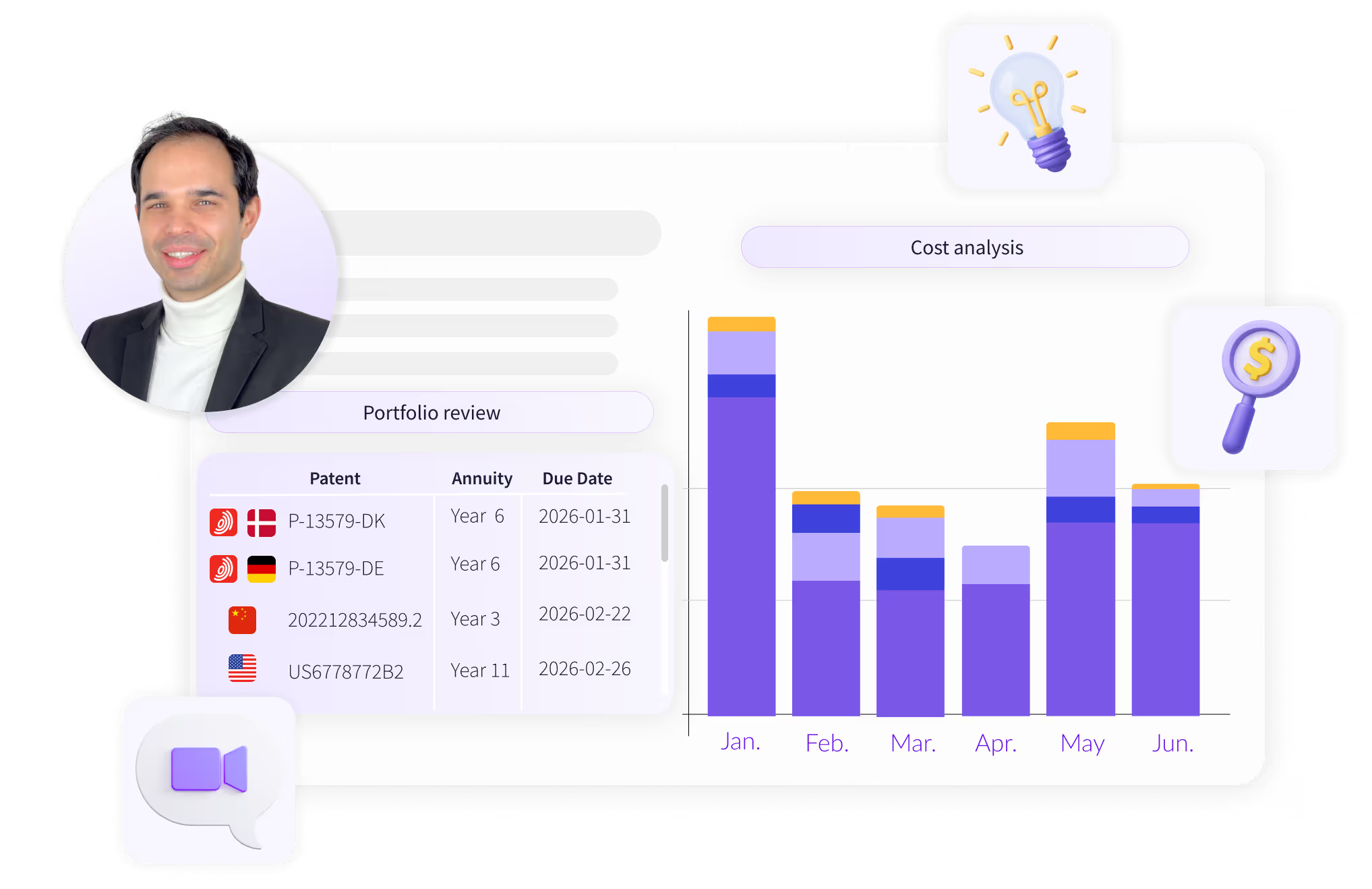TRY OUR NEW (FREE) IP RENEWAL COST CALCULATOR
Calculate

In this blog, we uncover the top 10 most innovative countries in 2025, highlighting changes from last year’s rankings and exploring what these shifts signal about global innovation trends.
Patent filings provide one of the clearest indicators of innovation leadership. The latest international patent activity report — the WIPO 2025 Patent Cooperation Treaty (PCT) Yearly Review — highlights which countries are at the forefront of innovation in 2025.
Dive in to discover who's leading the way and what it means for their economic strategies and growth.
Let’s dive deeper into the global patent filing landscape and what it means for IP owners navigating innovation in 2025.
Patent filing isn’t just a technical step, it’s a key indicator of innovation investment. For companies, protecting intellectual property globally via the PCT system shows long-term confidence in an invention’s value. It’s also a costly process, meaning only serious R&D strategies survive.
This year’s rankings reflect which economies are investing heavily in innovation, and how geopolitical, financial, and policy decisions are influencing those moves.
According to WIPO’s latest report, 273,900 international patent applications were filed through the PCT system in 2024. That’s a 0.5% increase, but the real story lies in where these filings came from.

Asia now dominates the landscape, accounting for over half (56.3%) of all PCT applications, up from just 40.6% a decade ago. Meanwhile, Europe (21.7%) and North America (20.6%) continue to contribute significantly but are no longer growing as quickly.
Despite the broad participation from 124 countries, 95% of all applications originated from just 10 nations, underscoring how concentrated patent activity remains.
Let’s count down the top 10 countries based on PCT filings in 2024, and explore the innovation profiles that shaped their positions.
10. Netherlands – 4,310 patent filings
The Netherlands retained its place in the top 10 despite a slight decline from 2023. Known for world-leading companies in semiconductors, renewable energy, and agriculture tech, the Dutch innovation ecosystem remains highly globalized. Over 50% of its PCT filings involve foreign co-applicants, highlighting a strong international R&D orientation.
9. India – 4,552 patent filings (+22.2%)
India recorded the largest growth among all top countries in 2024, with over one-fifth more PCT filings than the previous year. This jump is largely attributed to Indian businesses increasing their global patenting strategies, especially in pharmaceuticals, biotech, software, and electronics. India’s patent surge also reflects national initiatives like the “Digital India” and “Make in India” programs.
8. Switzerland – 5,324 patent filings
Switzerland continues to outperform many larger countries, thanks to its robust pharmaceutical, chemical, and medical device sectors. Companies like Roche and Novartis contribute heavily to the country’s IP output. With strong university–industry ties and high per capita R&D spending, Switzerland maintains a strong reputation for high-quality, globally relevant innovation.
7. United Kingdom – 5,861 patent filings (–2.6%)
The UK experienced a modest decline in PCT filings, but it remains a global innovation hub. Major strengths lie in health tech, fintech, and AI. University R&D is still a strong contributor to national filings. Interestingly, the UK led the top 10 in gender diversity among inventors, 37% of its applications included at least one woman inventor.
6. France – 8,125 patent filings (+0.8%)
France saw marginal growth in filings, with strong contributions from public institutions like CNRS and the CEA. National innovation is focused on green technologies, aerospace, and industrial automation. France’s IP activity is supported by coordinated public–private partnerships and a renewed focus on European industrial sovereignty.
5. Germany – 16,721 patent filings (–4.2%)
Germany remains a central player in European IP, though filings dropped sharply in 2024. Traditional sectors like automotive and mechanical engineering are still dominant, but the country is facing pressure to transition into digital and sustainable technologies. Many companies are also shifting parts of their strategy to the Unitary Patent system.
4. South Korea – 23,851 patent filings (+7.1%)
South Korea’s continued growth sets it apart from most other top-filing nations. With globally dominant firms in electronics, display tech, semiconductors, and batteries, Korea shows a highly concentrated but effective innovation model. Local R&D policies and strong export orientation support its rise.
3. Japan – 48,397 patent filings (–2.2%)
Japan’s downward trend continues, reflecting broader economic slowdowns and an internal shift toward patent quality over quantity. Still, Japanese companies remain global leaders in robotics, materials science, and imaging technologies. Tokyo–Yokohama is still the world's largest urban patent cluster by filing volume.
2. United States – 54,087 patent filings (–2.8%)
The US saw the steepest decline among the top three, continuing a multi-year dip. That said, it remains a dominant force in innovation, especially in semiconductors, life sciences, AI, and digital platforms. US universities continue to top global PCT university rankings, led by the University of California system.
1. China – 70,160 patent filings (+0.9%)
China stayed at the top, but its growth has significantly slowed compared to past years. This change is largely due to the rollback of government patent subsidies and a shift toward stricter quality control. Huawei remains the top global filer. China’s innovation strategy is focused on strategic sectors like 5G, EV batteries, AI, and telecom.

The WIPO report shows clear shifts in the types of technologies dominating international patent filings. Here's what 2024’s data reveals:
Digital communication
Computer technology
Electrical machinery, apparatus, energy
Medical technology
Pharmaceuticals

Other growing sectors include biotechnology, measurement technology, and transport. Meanwhile, fields like basic communication processes and chemical engineering saw modest or declining interest.
These shifts not only show where companies are investing their R&D budgets, but also indicate what IP owners will need to protect globally over the next decade.
The WIPO report shows that 89.1% of all PCT applications came from the business sector in 2024. Universities accounted for just 5.6%, while individuals made up 3.5%, and public research organizations the remaining 1.8%.
In high-income countries like the US and Japan, business dominates filings. But in middle-income countries, such as Peru or Morocco, public institutions and universities often play a much larger role.
The University of California was the top university filer globally, with 519 applications. The University of Texas, Tsinghua University, and the University of Michigan also ranked among the top 10 academic filers.
In 2024, only 18% of listed inventors in PCT applications were women. While this marks a modest increase, progress is slow. Some countries, like China and Türkiye, have comparatively higher proportions of women inventors, but the global gap remains significant.
Countries with high female participation often have strong university involvement in filings and targeted gender equity policies in science and engineering fields.
Patent filing activity is one of the clearest signals of where the innovation economy is headed. While Asia continues to lead in volume, regional shifts, sector priorities, and R&D funding decisions all play a role in who files and where.
If your business is innovating globally, your patent strategy has to follow suit. That includes smart decisions not just about filing, but about how you renew your IP assets over time.
And that’s where we can help.
At PatentRenewal.com, we help companies around the world renew their patents, trademarks, utility models, and design rights, while reducing IP renewal costs by up to 50%.
Our platform and expert team provides full control, transparency, and affordability, whether your business has IP rights in just one country or in more than a hundred.
Interested in a free IP renewal consultation? Benchmark your current IP renewal setup and costs against market standards.
